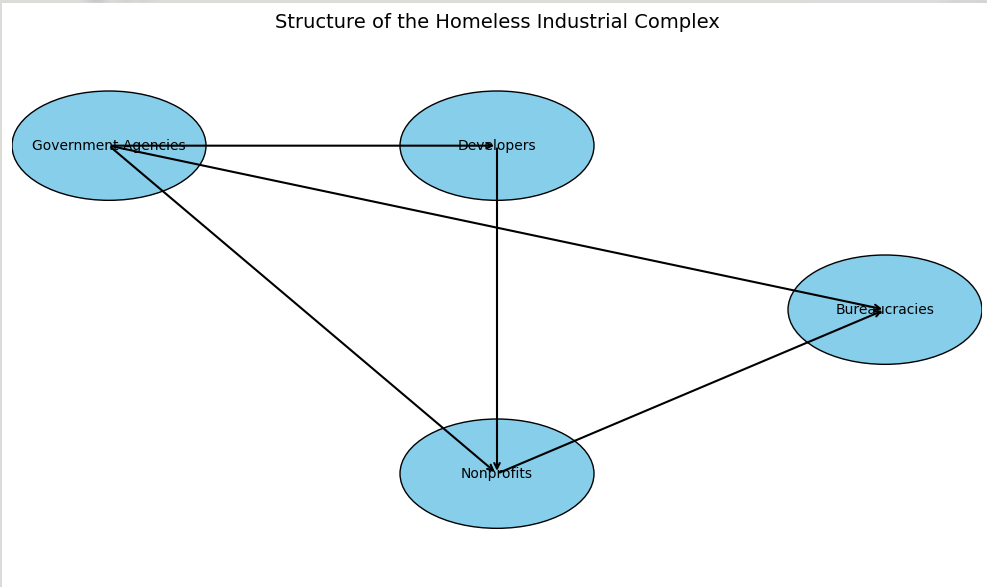The state of California has been pouring billions of dollars into addressing its homelessness crisis, yet the problem continues to worsen. This paradox has led experts to identify a systemic issue known as the “Homeless Industrial Complex,” which reveals how inefficient government spending and misaligned incentives are exacerbating rather than solving the homelessness problem.
Structure of the Homeless Industrial Complex

The Homeless Industrial Complex in California consists of several interconnected components:
- Government Agencies: Federal, state, and local governments allocate public funds for housing projects, set policies, and provide oversight[1][3].
- Developers: These entities receive public money to construct housing for the homeless, often at exorbitant costs[1][4].
- Non-profit Organizations: They operate and manage completed projects through long-term contracts[6][7].
- Bureaucracies: Government officials hired to manage and oversee projects, contributing to increased administrative costs[3][7].
How the System Operates
- The government allocates substantial public funds to address homelessness.
- Developers use these funds to construct high-cost housing projects, such as “permanent supportive housing.”
- Local governments collect building fees and expand their bureaucracies.
- Completed facilities are handed over to non-profits with long-term operational contracts.
- Ultimately, only a fraction of the total budget reaches actual homeless individuals[1][7].
Key Issues in the System
Excessive Costs
The cost per unit for homeless housing has skyrocketed, with some projects in Los Angeles costing over $440,000 per unit[1]. This level of spending is unsustainable and diverts resources from more efficient solutions.
Lack of Accountability
A state audit revealed that California spent $24 billion on homelessness over five years, yet the homeless population increased by 30,000 during this period[1][2]. The audit found that the state lacks consistent methods for tracking program outcomes and effectiveness[2].
Misaligned Incentives
The current system inadvertently creates incentives for various stakeholders to perpetuate homelessness rather than solve it. Non-profits, developers, and government agencies benefit from continued funding, which depends on the persistence of the problem[3][7].
Ineffective Resource Allocation
Despite the massive spending, the number of homeless individuals in California has increased by 53% in the last decade, reaching an estimated 180,000 people[10]. This suggests that the current approach is not effectively addressing the root causes of homelessness.
Conclusion
The Homeless Industrial Complex in California represents a systemic failure in addressing homelessness. While initially well-intentioned, the current system has evolved into an inefficient and potentially corrupt mechanism that wastes resources and fails to provide effective solutions for those experiencing homelessness.
To address this issue, California needs to implement significant reforms, including:
- Improving transparency and accountability in fund allocation and usage.
- Reevaluating the cost-effectiveness of current housing projects.
- Focusing on evidence-based interventions that directly address the needs of homeless individuals.
- Streamlining bureaucratic processes to reduce administrative costs.
- Implementing rigorous performance metrics to ensure programs are achieving desired outcomes.
Only through comprehensive reform and a renewed focus on efficiency and effectiveness can California hope to make meaningful progress in addressing its homelessness crisis.
Citations:
[1] https://sfist.com/2024/04/09/state-audit-blasts-california-for-spending-24-billion-on-homelessness-but-not-tracking-whether-much-of-it-works/
[2] https://www.cbsnews.com/sanfrancisco/news/california-homelessness-spending-audit-24b-five-years-didnt-consistently-track-outcomes/
[3] https://www.citywatchla.com/los-angeles/27582-does-the-homeless-industrial-complex-exist
[4] https://californiaglobe.com/fl/california-state-auditors-scathing-homeless-report-where-did-the-money-go/
[5] https://www.independent.org/news/article.asp?id=14999
[6] https://californiapolicycenter.org/americas-homeless-industrial-complex-causes-solutions/
[7] https://www.hoover.org/research/despite-california-spending-24-billion-it-2019-homelessness-increased-what-happened
[8] https://www.nationalreview.com/the-weekend-jolt/californias-homeless-industrial-complex-exposed/
[9] https://californiapolicycenter.org/the-homeless-industrial-complex/
[10] https://www.cbsnews.com/losangeles/news/scathing-report-criticizes-accountability-of-californias-homeless-funding/



















































































